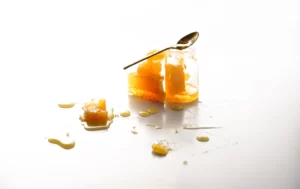Table of Contents
What is MGO?
Have you ever seen a jar of honey with a number next to it? 5+, 10+, 15+? Or MGO 70+, MGO 100? Or TA 10+? Or NPA 15+? Or UMF 10+? And the higher the number the more expensive the honey? What do all these numbers mean? These numbers indicate active honey. Active honey is honey that has been tested and certified by an independent laboratory to possess antibacterial “activity.” Although manuka is the most commonly known active honey, other honeys also have antibacterial activity. Activity in honey is usually measured by a number, e.g., 5, 9, 13, 17, etc. which the testing laboratory determines in tests. Here is a sample test report:
| Activity Grade | Rating | MGO (mg/kg) |
|----------------|--------|-------------|
| 10+ | Moderate | 100-263 |
| 15+ | Useful | 263-514 |
| 20+ | High | 514-829 |
| 25+ | Very high | 829-1232 |
| 30+ | Superior | 1232-1736 |
On a honey jar label this grade is often rounded off to the nearest multiple of 5, e.g. 5+, 10+, 15+, 20+, for example:
- The higher the number, the higher the antibacterial potency (or bacteria killing power) of the honey.
- Honeys with an activity of below 10 are not considered to have significant antibacterial potency to kill bacteria. So you should try to avoid buying active honey which has an activity rating below 10.
- Honeys with an activity rating of 20+ or more are considered very powerful and are usually the most expensive.
- Genuine manuka honey with a TA of 20+ retails at up to £100 a jar.
Types of Activity in Honey
There are two types of activity in honey: Peroxide Activity (PA) and Non-Peroxide Activity (NPA). In manuka honey, NPA is also sometimes stated as UMF (Unique Manuka Factor) but they are exactly the same thing. Peroxide Activity is bioactivity caused by the presence of naturally occurring hydrogen peroxide in honey. Non-Peroxide Activity is bioactivity caused by the presence of other bioactive compounds in the honey.
For example, a honey with a PA of 12 and a NPA of 7 has a Total Activity of 19 and may be labelled on a jar as TA 15+. Peroxide Activity is known to degrade with heat and time so pasteurizing, or heating honey, above 45C can kill some of its bioactivity. So you should never heat or microwave active honey. As for time, Peroxide Activity degrades very slowly over many years, which is far longer than the average time a jar of honey lasts in a kitchen.
MGO and UMF
MGO is short for methylglyoxal, which is another way of measuring the activity of honey, but is usually only used with manuka honey. MGO is NOT the same as the UMF value. The table below shows the equivalence. So an MGO 70+ is not better than a UMF 20+. In fact, an MGO 70+ is the lowest grade of honey with very little antibacterial properties. Some manuka retailers cleverly market their honey with their MGO value in large font because on a shop shelf most consumers will not know the difference between MGO and UMF. They will simply think that the higher number is better, and buy that, not knowing that it will hardly do anything for them.
| MGO Grade | UMF Equivalent |
|---|---|
| 10+ | 5+ |
| 70+ | 10+ |
| 100+ | 12+ |
| 200+ | 15+ |
| 250+ | 18+ |
| 400+ | 20+ |
Benefits of Active Honey
None really, except that manuka is more well known, a few celebrities use it and thus, much more expensive. A honey with a Total Activity of 20+ has exactly the same antibacterial activity as a Manuka honey with a Total Activity of 20+. Active honey is more expensive than other honeys because it is proven to have something that benefits you. When compared to the amount of money people spend on artificial vitamins and cosmetics to strengthen their bodies or their skin, active honey is not actually that expensive. It has no side effects when used in moderation. It can be eaten and applied on the skin. Active honey is very powerful. This is why it is more expensive than other honey. You can use active honey like any other honey but it is normally used to build a weak immune system, replenish the body after surgery or to fight infections. If using 20+ active honey, half a teaspoon dissolved in half a glass of warm water first thing in the morning is sufficient. For 10+ active honey, use a teaspoon mixed into a glass of warm water first thing in the morning. You can repeat this twice more throughout the day. Active honey can also be applied on the skin. Up to 20 minutes at a time on the face and overnight on other parts of the body. Always test an area of skin first for a short time before building up.
Choosing Active Honey
Surely, anyone can just add a number to a label? Simply ask the supplier that you wish to see the certificate from the laboratory which tested the activity rating of the honey you are buying. This should be in addition to your usual checks about the company you are buying from: their name, address, registration and license numbers, internet presence, etc. The Latin Honey Shop sells two laboratory certified active honeys. One is the Active Multifloral Honey 20+ TA and the other is the Active Multifloral Honey 10+ TA. Both are tastier and affordable alternatives to manuka honey.
Please note, comments must be approved before they are published.



